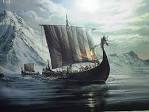A recent study has found evidence to suggest that Viking women travelled with men as they explored for new lands to colonize.
This is in contrast to other major civilizations where men were the ones to travel overseas and find new places to settle. The Norwegian families appear to have actually traveled with their families with them.
This is a major discovery as it was previously believed that Vikings were similar to their European counterparts.
It used to be widely believed that Viking expeditions was made up entirely of men, and that the shortage of women at home drove Viking men to look for women in foreign lands.
The research appears in The Royal Society Philosophical Transactions B. It is the first of its kind to indicate that women played a significant role in Viking migrations.
Researchers analyzed Viking mitochondrial DNA – gathered from around 45 Norse skeletons dated from 796 to 1066 – to the mitochondrial DNA of more than 5,000 modern people from the Scottish mainland, the Shetland and Orkney Islands, Norway, Sweden, England, Germany and France.
They found that the ancient mitochondrial DNA was very similar to that of the modern Northwestern Europeans.
These results show that families traveled in groups during their period of expansion.

The Ravager, a painting by John Charles Dollman
Researcher Maja Krzewinska said:
“We can also show that our Norwegian Vikings brought Norwegian women when they colonized Iceland and went to other areas. It fits well with what we know from written sources and gives us an exciting picture of how migration was done in groups with mobility like the Vikings.”
Vikings are known to have established colonies in Iceland and many parts of Northwestern Europe. They are thought to have also traveled as far as North America.
Senior study author Ander Gtherstam commented:
“What we think we can see now is that the mobility and the demographic dynamics have been greater than we previously imagined. But give us a few more years and I think we have a clearer picture of the demographic history in our latitudes.”
The research team is aiming to improve our understanding of the relationships between the ancient Norse and other ancient peoples by studying ancient British DNA.
Reference
“Mitochondrial DNA variation in the Viking age population of Norway” Philosophical Transactions B
Authors: Maja Krzewińska, Gro Bjørnstad, Pontus Skoglund, Pall Isolfur Olason, Jan Bill, Anders Götherström, Erika Hagelberg
DOI: 10.1098/rstb.2013.0384 – Published 8 December 2014

